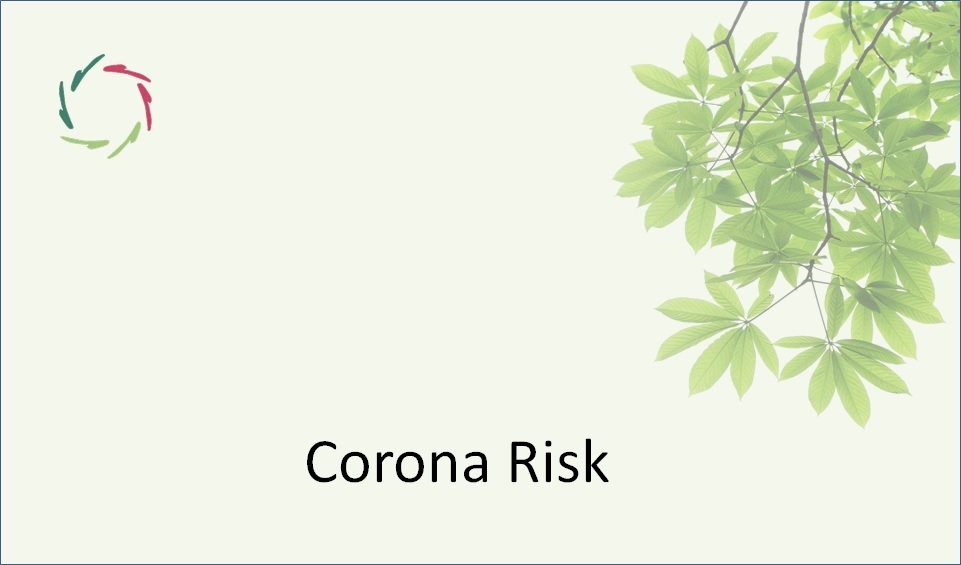10. Corona Risk

June 6, 2020
Today we have these coronavirus curves, worldwide:

This is not positive. On the 2nd of May (see ‘ Worst Case COVID’), I was appalled by the linear curve of caseload until then. Today, it’s still linear! The number of deaths per day is slowing down a bit, but not substantially over the last four weeks. We’re at +/- 5000 deaths per day worldwide. Including the not officially counted cases, there are probably many more.
In European countries, the numbers are generally falling: much fewer cases and deaths per day. In Belgium, we’ve come from 300 deaths to 20 deaths daily over two months. That is already fantastically good news. As a result, people are going back to the reopened shops, fitness parlors, restaurants, and other public venues. The mental atmosphere is one of relief and exhilaration, with some caution. It feels like coming out of a nightmare. Economically also, we are licking our wounds and try to recover as if we have escaped the monster for good. We were sinking; now, our children’s money is being spent to get us back afloat asap. Of course, everybody feels ready to renew economic activity. At the same time, this reopening is going unexpectedly quickly. Most virologists acquiesce, be it reluctantly. We don’t know what is happening exactly. Have we lockdowned the virus away or is it something else?
I’ve never hoped so much to be wrong as I am hoping to be now. What I see in the evolving curves is a negative spiral starting mid-march. I described it back then as a kind of ‘hysteria.’ In retrospect, more than at the time, this seems a well-chosen term. Hysteria is a phenomenon that happens largely at the subconceptual (mainly non-conscious) level. Conscious control is not a significant factor in this, which is why it is invisible. Not for that, insignificant.
In the way that I saw things happening, the virus pandemic came together with a mental epidemic of hysteria, panic, nocebogenic thoughts: “This is going to be excruciatingly bad.” The personal stress and global hysteria played crucial roles in engendering a negative spiral for many, a whirlpool being energized not only by the virus.




In other parts of the world, the disaster is still going on or just starting. Looking at some curves of daily cases until the present:
You note the recurring trend. This looks like the start of a pandemic in these countries. On top of this, these are countries where the actual numbers are probably much higher already. They have no means to keep count of reality as in Europe and the US, nor do they have as much incentive to do so. To be honest, it puzzles me why some parts of the world are lagging in time behind Europe and the US. One can only see it happening. Also puzzling is Africa: still largely resistant to the virus, although not to social and economic downturn.
Back to Europe. Borders are reopening. Tourism is promoted almost everywhere on the continent. People feel more and more at ease. Confidence provokes something like the opposite of a negative spiraling. Indeed, we see a positive spiraling, which may be playing according to the same principle as the negative one. Gone is distress (to a considerable degree) and its influence on the immune system. Thus, indeed, the stress-niche of the virus is crumbling. Everybody happy, but the lesson has not been learned. To me, the positive evolution that we are witnessing in Europe at present is an additional strong indication of pending danger. The spiraling may turn back to the other side. Without bad intentions, the media – including social media – may again play a huge role in feeding the whirlpool.
It makes me remember the images from Italy that we saw right before the ‘hysteria + pandemia’ came hitting with force. As long as the lesson has not been learned, we are at risk of a new and stronger Covid-19 wave. It’s like giving a blow with a hammer, then pulling it up to give a second blow.
I’m not writing this to scare anyone without substance. The being scared may have played a big role in the happening. It may also play a significant role in what is to come. Virologists are warning for a second wave in the autumn. We don’t know the virus well enough to assume that it will act like Influenza, giving us an intense visit each autumn and winter. If so, then we have two infections at the same time entering our continent and homes. Being different viruses, they may compete between them, but not much. Thus, people may get sick twice at the same time. This also resembles the Spanish flu in the sense that in its second wave, most people succumbed from superinfections.
Meanwhile, herd immunity has not been built against our corona-guest. In Belgium, we are at 6%. Better said, 94% is not immune (some say a bit less). That is almost the total population. Add to this some other unknowns about this specific virus, such as how long people stay immune.
Andrea Ammon, director of the European Centre for Disease Prevention and Control, warns for a second wave in clear terms: “not if but when and how big… people think it’s over, which it isn’t… it definitely isn’t” [https://www.euractiv.com/section/coronavirus/news/not-if-but-when-european-health-boss-warns-of-virus-second-wave/
I fear most that we will again get into a negative spiral, a whirlpool of mind + virus acting in detrimental ways upon the immune system and other physiological defenses, heightening the negative spiraling and starting the same song. On the one hand, there is better protection (masks, instruments, knowledge about the impact of social distancing). On the other hand, the virus may also evolve towards surpassing this protection. As is common in the natural setting, it does so in a brute-force learning over many viral generations. And many generations there are. With each one, viruses may mutate in different directions, including ones that can better take advantage of the niche. Younger people may become targets of infectiousness; the incubation period may prolong; more people may become super-spreaders.
I strongly hope this will not be the case. But we have a history of such, some 100 years ago. The Spanish flu was extremely deadly (10-100 million people) only in its second wave, in the autumn of 1918, after a relatively mild first wave in the spring of that year. The second wave came from a mutated virus. The more people get infected now, the more chance we have to see such a mutation happening.
The lesson that we should learn – in any case – is a lesson about ourselves. We are nature, and we are very complex beings. That is a strength and a weakness. If we learn to deal with it better, we can flip the balance more to the former. Otherwise, before the end of this year, there will again be much more deaths than need be. Plus: what about the economy if the second wave hits us as hard or harder than the first one? It is not possible to keep pouring trillions of dollars and euros in keeping businesses and people afloat.
Thus, the next hysteria-fed whirlpool may be even way more pronounced in that near future. A bit further ahead, a next stress-niched coronavirus may come to haunt us. Actually, the question is not ‘if’ but ‘when.’ Will the lesson have been learned? Will humanity be better prepared? We have an opportunity now to diminish also future disaster.
I don’t want to scare anyone just for diversion. We are at a moment when things can turn out very badly in a way that only some living humans have seen before. At least, we should examine this from every possible angle. I don’t see it happening.
In conclusion: The absence of mind in Covid-19 causal thinking is costing many lives. It may cost many more even by the end of this year. I am urging appropriate research at the highest level. It would be devastating to see the need for this only in retrospect.
The future
Well, mainly in a few months already. Since I don’t have a crystal ball, this comes from intuition, rational thinking, a whole lot of research, and experience.
Until the miracle vaccine is developed, this virus will stay present on the planet, going up and down in different areas. The economy will drive individuals and groups to persistent risk-taking behavior.
In Europe and the US, autumn will come with an influenza epidemic like every year. This year will combine the influenza season with a resurgence of corona, and with the risk of hysteria resurgence. If the latter enters the picture profoundly, there will be a renewed whirlpool phenomenon in many individuals and society. Another lockdown be postponed for directly economic reasons, at least in several areas, adding to the whirlpool: heightening the risk of an even more severe lockdown and economic downturn, people becoming more and more aggressive to one another about core values (immediate life versus money and the future). Politically, the doors will be ajar towards some forms of ‘very tough leadership.’ Something ‘like we have never seen before’ in recent times?
In the socially most prudent cultures (China, Japan, South-Korea), the damage will be least.
In the poorest areas of the world (much of the underbelly), there is no way this virus will stop. Look at a combination of the necessity of people going to work with an impossibility to protect themselves. This happens within an environment of additional risk factors, such as protein deficiencies, and the lack of medication for superinfections.
The biggest risk is a virus mutation into a much more human-unfriendly form. Of course, at the individual virus-level, the risk is infinitesimally small. But there are many viruses. Each new infection adds to the risk. This is one crucial element in the competition between virus and humanity. Thus, several factors are reminders of 1918. This may seem far-fetched until it happens. At least, the risk is real. What shall we do?
Meanwhile, the race is not simply between the virus and conceptual thinking: face masks, social distancing, virus-blockers, vaccines. The race includes – and will be mostly determined by – subconceptual thinking: the so invisible meaning-level that defines our humanity in many ways. At other places, I have written extensively about it as our ‘basic cognitive illusion.’ It is the only important level given any definition of ‘importance’ itself. In the few months and years to come, it will be central to the existence of millions and the wellbeing of billions.
I mean, virus-related.
After that comes the next challenge.


